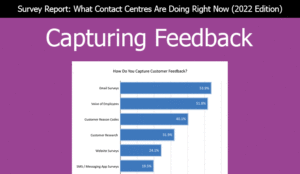Francis Beard at Sabio Group explores how often you should seek customer feedback.
Outstanding customer experience (CX) begins with knowing what customers need and want – as well as their habits, preferences and aspirations.
A voice of the customer solution helps manage feedback in smart ways and reads between the lines of customer interactions to truly understand so much more.
By gathering information from channels inside and outside the business – from emails, calls and chat to social media – it helps discover what’s really driving customers, and where your products and services can help.
The key is to avoid bombarding your customers with surveys, you must ensure that you gather both the passive and active feedback that they provide.
But how often should you listen to the voice of the customer? The short answer is always!
Passive Feedback
Passive feedback uses ‘always-on’ methodologies to harvest data from multiple digital sources.
Social media provides excellent insight, especially because conversations can generate feedback from multiple users.
Review sites such as Trustpilot and Google Reviews are also rich sources of data, where customers tend to be especially truthful with the aim of providing useful information for future users of a product or service.
Pretty much any online space where customers talk about your brand can be mined to create a powerful and detailed view of their needs, wants and aspirations.
There are, however, two key requirements to unlocking the passive feedback goldmine: firstly, you need to be able to house all the data in one place, and secondly, you need technology to automate the analysis of so much unstructured data.
At Sabio Group, we favour the use of Natural Language Processing (NLP) combined with sentiment analysis. This pairing not only tells you what your customers are saying but crucially, how they feel about it, giving you the information you need to make the case for change.
Active Feedback
Active feedback relies on the traditional method of surveying your customer at different points in the customer journey – but choosing when to survey (and when not to!) is all important.
We recommend using survey fatigue prevention measures to ensure that customers receive a survey no more than once within a 30-day period.
This will free you up to design a robust and reliable voice-of-customer programme using both transactional and relationship surveys. Transactional surveys measure customer loyalty and experience after a specific interaction or transaction.
At Sabio, we have worked with hundreds of organisations to help them identify the critical touchpoints in their customer journey which, depending on your sector, could be anything from onboarding to post-contact or from repair to renewal.
Once identified, the next step is designing a survey that helps you measure your strategic customer outcomes at each touchpoint and identifying the most appropriate channel on which to send the surveys.
Once in place, your suite of transactional surveys will provide your organisation with rich insight regarding the pain points in your customer journey and how they impact loyalty, as well as the aptitude and attitude of your employees and how that impacts loyalty.
Relationship surveys measure customer loyalty to your organisation or brand, irrespective of any recent interactions. We typically recommend sending a relationship survey to your whole customer base every six or twelve months.
Relationship surveys are far more in depth than transactional surveys and have the advantage of talking to the ‘silent majority’ – those customers who you haven’t spoken to recently and therefore have no indication as to their loyalty or churn risk.
What a Voice of the Customer Solution Can Do…
- Generate and manage surveys and forms – tools that help you ask customers for feedback at the right times and gather and analyse the results.
- Analyse language and sentiment – uses Natural Language Processing to identify motivation and intention across all your channels, from social listening to speech analysis.
- Measure and track performance – view customer satisfaction over time, across different parts of the journey.
- Support your team – easy-to-use dashboards bring your information in one place, with customisable permissions and views for different roles.
- Integrate with existing technology – works with platforms like Genesys and other popular CRM or ERP software, so it simply runs alongside your current systems.
For more information about Sabio - visit the Sabio Website
Call Centre Helper is not responsible for the content of these guest blog posts. The opinions expressed in this article are those of the author, and do not necessarily reflect those of Call Centre Helper.
Author: Sabio
Published On: 27th Sep 2022
Read more about - Guest Blogs, Sabio






 Sabio Group is a global digital customer experience (CX) transformation specialist with major operations in the UK (England and Scotland), Spain, France, Netherlands, Malaysia, Singapore, South Africa and India. Through its own technology, and that of world-class technology leaders such as Amazon Connect, Avaya, Genesys, Google Cloud, Salesforce, Twilio and Verint, Sabio helps organisations optimise their customer journeys by making better decisions across their multiple contact channels.
Sabio Group is a global digital customer experience (CX) transformation specialist with major operations in the UK (England and Scotland), Spain, France, Netherlands, Malaysia, Singapore, South Africa and India. Through its own technology, and that of world-class technology leaders such as Amazon Connect, Avaya, Genesys, Google Cloud, Salesforce, Twilio and Verint, Sabio helps organisations optimise their customer journeys by making better decisions across their multiple contact channels. 





























